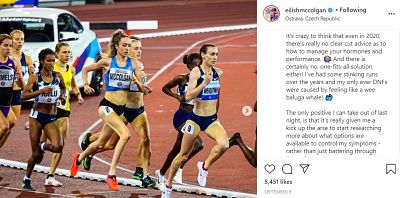The average woman will have around 480 periods during her lifetime. And even though it's a normal part of life for around half of the world's population, the menstrual cycle remains a taboo subject.
The symptoms many women face each month as a result of their periods can be debilitating and affect the body in a variety of ways. It's fair to assume that those symptoms will have a significant impact on a female athlete's ability to perform.
But, how does the menstrual cycle affect an athlete's training and race performance?
Phases of the Menstrual Cycle
Before we delve into the symptoms and effects they can have on performance, we need to understand the different phases a female's reproductive system goes through each month.
1. Menstrual phase
What happens? The first phase of the cycle is when we experience the period. If the egg from the previous cycle hasn’t been fertilised, levels of the hormones oestrogen and progesterone drop. The thickened lining of the uterus is not needed, so it's broken down and exits the body as our period.
Timespan: This phase typically lasts between 3-8 days.
2. Follicular phase
What happens? The follicular phase happens alongside the menstrual phase, both starting on the same day.
Hormonal changes begin with a part of the brain called the hypothalamus telling the pituitary gland to release follicle stimulating hormone (FSH).
As levels of FSH rise, tiny sacs of fluid known as follicles grow inside the ovaries, each housing an egg whilst it matures and grows.
Levels of oestrogen rise, which causes the lining of the uterus to thicken in preparation for a fertilised egg to arrive.
Timespan: In total, this phase lasts between 1-3 weeks.
3. Ovulation phase
What happens? Now the egg has grown inside the follicles, it's ready to be released. The mature egg leaves the ovary and travels down the fallopian tube, all the way down into the uterus.
If the egg meets a sperm during this journey, it can become fertilised.
Timespan: If the egg is not greeted by a sperm and doesn’t become fertilised, it will survive for about 24 hours before dissolving.
4. Luteal phase
What happens? The final phase of the menstrual cycle.
The lining of the uterus (scientific name: "endometrium") is thick in preparation to support a pregnancy and is maintained by high levels of oestrogen and progesterone. If the egg that reaches the uterus is fertilised, the body will release more hormones (Human Gonadotropin) to keep the lining thick and support the egg to develop into an embryo.
If the egg isn’t fertilised, levels of hormones drop. This then allows the endometrium to break down and get removed from the body in preparation for the next cycle.
Timespan: The luteal phase typically lasts around 2 weeks, and is where we commonly experience PMS (Pre-Menstrual Syndrome) symptoms.
After this, we go back into the menstrual phase and the cycle begins again... every month... for around 35 years of our lives...

How the body responds to the menstrual cycle
So, that's the science covered but that actually happens to a woman's body during this cycle?
The body faces many changes throughout the different phases of the cycle. It’s estimated that around 80% of women experience some sort of pre-menstrual symptoms, such as:
- Abdominal cramps
- Bloating
- Muscle aches
- Tiredness
- Poor sleep
- Anxiety
- Trouble concentrating
If I'm totally honest, my menstrual cycle is an absolute nightmare with regards to athletic performance. I always perform well below my fitness level which is extremely frustrating.
I get really bad stomach cramps, heavy legs and a tight lower back/hips, which all affect performance.
It's actually the reason for my only two DNF's during a competition. It's finally got to breaking point for me this year, where I feel I need to find some sort of solution to help calm my symptoms.
This winter, I'll be making some changes and trying out different solutions to find something that can work best for my body.
2x Olympic middle-distance runner Eilish McColgan

If you ask your female colleagues, teammates, friends, family and neighbours about the symptoms they experience, you will likely get very different answers from them all.
Some notice little difference throughout their cycle, whereas others have symptoms that leave them bedbound for a day.
I have been one of the lucky ones and really had no noticeable issues or performance losses during my menstrual cycle. The only thing for me was always the inconvenience of being outdoors with little access to toilets all day, every day, so that was sometimes tricky!
Former World Downhill and Enduro MTB champion, Tracy Moseley
Alongside this, the hormones involved with the menstrual cycle can have other effects on the body.
Progesterone has a thermogenic effect, meaning it can cause an increase in core temperature. This can have an effect on breathing rate and depth, and heart rate which can increase by as much as 7 beats per minute per 1°C (33°F) rise in core body temperature.
When oestrogen is dominant in the first half of our cycle, we become more reliant on stored fats for energy. Using fats as our predominant source of energy allows the limited stores of glycogen (stored carbohydrate) to be maintained for a longer period of time.

How the menstrual cycle affects endurance performance
Ask a female athlete about her cycle, and the response may range from silence to an outpouring of angst.
Accounts by many female athletes show varied experiences of PMS symptoms and menstrual changes, and the impact on performance.
Unfortunately, this means there isn’t a one-size-fits-all approach to controlling them.
Negative effects
During the luteal phase of the menstrual cycle (second half) we see hormonal changes and PMS symptoms that can no doubt have detrimental effects on exercise performance.
The 2020 Elite British Sportswoman Survey found 59.8% of athletes were affected by their period. Lower energy levels, aches, headaches, bloating and cramps will take a physical and mental toll, and can limit athletic performance.
When progesterone is highest during this phase, the increase in core temperature, breathing rate and heart rate can make exercise seem harder. This is because the muscles involved in breathing use more oxygen, which means there is less left over for the muscles to use.
As well as this, these effects can make it significantly harder to exercise in the heat, which is an issue when training or competing in hotter climates.
Each month, I have a horrendous time with my menstrual cycle and it seems to get worse as I get older.
I have no idea if this is due to age or athlete-related stress, but either way they get more severe every month!
A few days before I am due to start my period, I will have a lot of irritation, short temper, irritable bowels, bloating and want to eat EVERYTHING in sight.
This isn't ideal for an athlete as it makes keeping in shape and eating quality nutritional foods difficult, especially when it comes around every 4 blooming weeks!
Enduro MTB World Series rider and 2018 British Enduro Champion, Bex Baraona

Positive effects
During the first half of the cycle, when oestrogen levels are high, we may see a benefit to endurance performance.
Oestrogen increases our reliance on fats for energy during submaximal exercise, which means we can exercise for longer before dipping into that all-important limited store of glycogen.
For the endurance athlete, this is great news, as it helps us to delay fatigue and improve our overall performance.
What can female athletes do to 'control' the effects of the menstrual cycle?
Unfortunately, there isn’t a one-size-fits-all approach to controlling the effects of the menstrual cycle, but there are a few different avenues to explore. If you have no negative symptoms throughout your cycle, you're one of the lucky ones!
Others may report symptoms but no impact on performance, such as Paula Radcliffe when she broke the marathon World Record in Chicago 2002 despite suffering period cramps in the last third of the race.
Even if you don’t think your menstrual cycle is having a huge impact on how you feel and perform, it might still be beneficial to keep track of when your period starts and ends, and see if there's any difference in your training or race performance.
Tracking the menstrual cycle
Apps such as Fitrwomen have been developed for women to track their menstrual cycle. They allow you to track symptoms and training (it can be linked to Strava), predict period start date, and also provides tailored nutritional and training suggestions based on the current phase of the cycle.
This allows athletes to adapt to the fluctuating hormones throughout their cycle. This then means athletes can get the maximal benefit from training, reduce injury risk and know when to prioritise recovery.
Adapting training
Ideally, the phases of the menstrual cycle shouldn’t have a huge impact on training. After your period, in the follicular phase, you may feel like you have more energy, and you're able to increase the duration / mileage in sessions.
Towards the end of the cycle, before the period, you may need to lower the volume and intensity of training if suffering with PMS symptoms.
However, many women report the best way to reduce symptoms like cramps is by going for a run, cycle or swim!
The day I start my period, I will often spend 2-5 hours in excruciating pain. I'm lucky this has never coincided with me needing to be on a start line of a race because I just simply wouldn't be able to.
It's not uncommon for me to miss training sessions or have to alter when and how I train on the day I start my period. It's annoying because consistency in training is key and it's really difficult to change the plan.
Bex Baraona
Adapting diet
During the follicular phase, where oestrogen is dominant, we are more reliant on fats for energy and our carbohydrate stores are preserved. For submaximal exercise this is great, but when hitting higher intensities, the working muscles need carbohydrates for energy.

So, during this phase we may need to increase carbohydrate consumption in order to hit the high intensities in training or a race. As the follicular phase follows our period, it’s also an important time to make sure you’re consuming enough iron, and vitamin C to help the body absorb it.
I've tried a host of different things but to be honest, nothing has had any real impact on my performance. I remove all gym work and intense training sessions in the lead up to my period, in order to try and reduce leg tiredness which definitely helps a little.
I sleep much more and focus on getting in more carbohydrates because I know my body is in a stressed position and utilising more energy.
Again, these small changes definitely help but unfortunately I'm still way below my best on race day.
Eilish McColgan
During the luteal phase where progesterone is high, the breakdown of proteins is increased, and energy expenditure is higher than usual.
Therefore, we need to ensure we are consuming enough calories from proteins, fats and carbohydrates to fuel exercise and recovery.
Contraception
The use of contraception with the aim of controlling the effects of the menstrual cycle is common amongst endurance athletes.
Clear benefits of using contraceptives such as the pill include stabilising hormones, lessening symptoms - such as heavy bleeding or cramps - and also allowing the timing of menstruation to be manipulated.
I used the pill once around a World Championships to avoid having a period at that time, but that was the only time I ever adjusted things with regards to my competition schedule.
Tracy Moseley
However, the research surrounding contraceptives and endurance performance is conflicting.
Some studies have shown certain contraceptives to have negative impacts, such as weight gain, which could impact your endurance performance. If you’re thinking about using contraceptives to control your cycle around training / competition, always consult a doctor first, and identify the risks and what works best for you.
Remember, we're all different.
Whether you’re looking for a competitive edge or you're a recreational athlete trying to minimise the effects of your cycle, or you're a coach who's working with a female athlete, it's important to gain as much knowledge as you can.
Tracking your periods, logging symptoms and analysing your athletic performance will help you to understand the amazing changes your body goes through every month.
And then you can use this knowledge to your benefit and use the information to help inform your decisions around training and racing.
